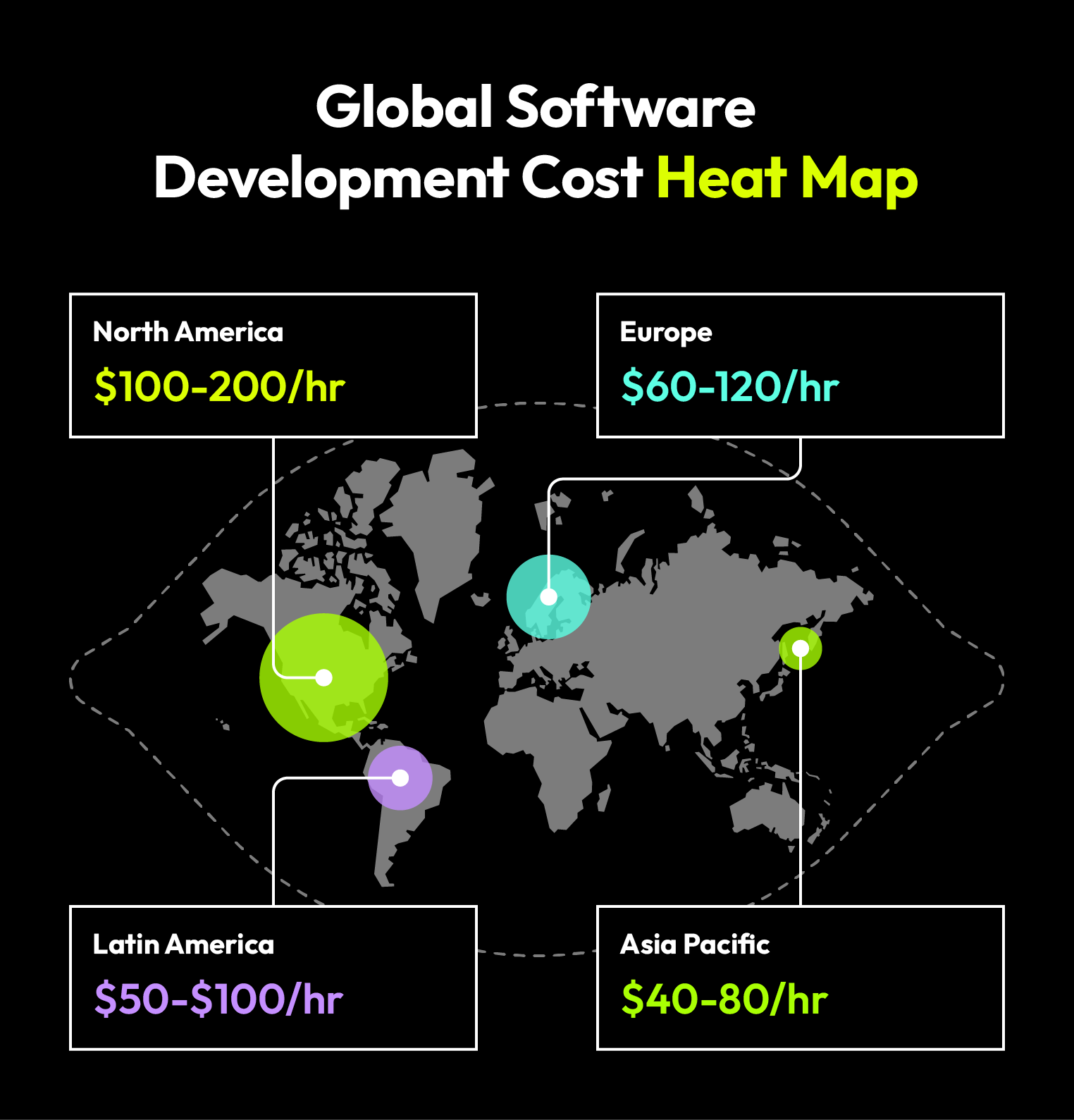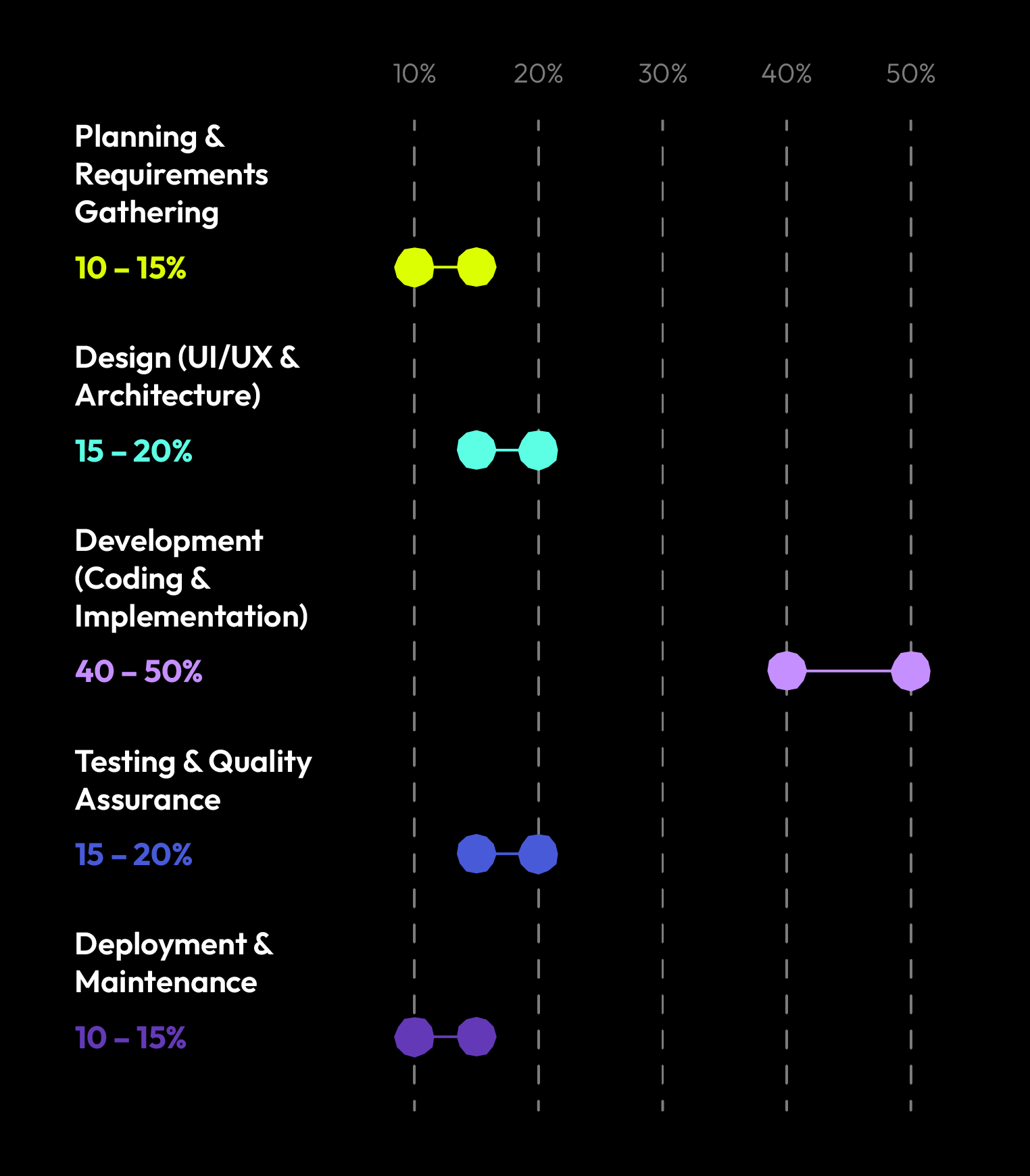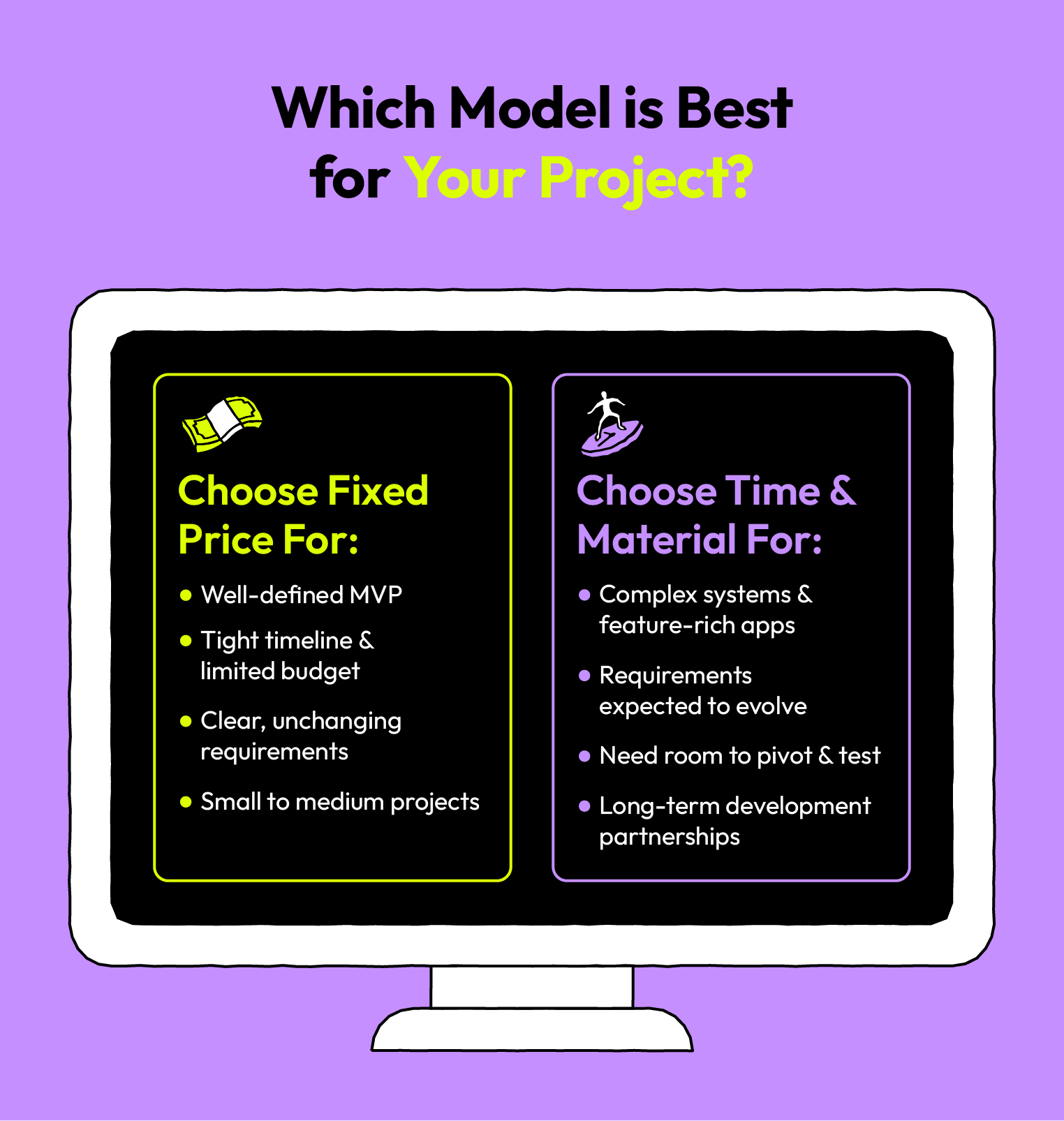Assessing software development costs is essential for nearly every stakeholder in your business, from project management to procurement. They tend to fluctuate based on factors such as your tech stack and where you outsource talent.
Let’s break down the real costs of developing custom software, from development models and team location to testing and legal support.
Whether you’re a software engineer or hiring developers, this guide will help you make smarter, future-proof decisions.
Key Factors Influencing Software Development Costs
Software development costs are usually driven by a complete mix of decisions that shape your team, tech stack, and timelines.
From the type of product you’re building to where your developers sit, each choice can tighten or explode your budget.
Let’s go over 10 of the most crucial factors that impact software development costs, complete with real-world use cases and considerations for teams scaling in 2025.
1. Complexity
Complexity is what separates a $25k build from a massive $250k application.
A basic application like an internal task tracker might involve a front-end user interface (UI), a simple CRUD API, basic auth, and a single relational database. One developer can build, test, and deploy this app on a single cloud instance in weeks.
Now, compare this app to something major like Slack. Slack is a multi-platform, real-time messaging system with file storage, advanced search indexing, and workspace-level permissions.
Building software like Slack requires horizontal scaling, WebSocket infrastructure, media handling, notification queues, multi-regional deployment, and enterprise-level data governance.
That level of complexity means:
- More specialized engineering roles, such as back-end, front-end, infrastructure, security, mobile, and quality assurance (QA).
- Higher QA surface area, as real-time systems are much harder to test than REST APIs.
- More architectural planning, since performance and reliability can’t be afterthoughts.
- More ongoing costs, since observability, logging, and compliance requirements scale with user load.
Overall, the more logic, concurrency, and interconnectivity your software demands, the more your software development costs will increase.
2. Type of Development
The way your software is built, as well as your development strategy, can radically change your cost structure. It’s not just about what you build, but also how you build it.
Different development methods come with varying flexibility, speed, and long-term scalability trade-offs. Below are the most common development types and what they mean for your budget:
- Custom development: This is full-control, ground-up engineering. Custom software application development is ideal for startups building unique intellectual property (IP) or platforms that can’t be boxed into templates.
- Low-code/no-code development: Tools like Bubble or OutSystems let you build workflows visually, often without writing much code. This method is suitable for internal tools or MVPs, but not for custom integrations.
- Off-the-shelf software: Platforms like Shopify and Hubspot can replace months of engineering with a subscription. However, you’ll trade flexibility for speed.
- Open-source development: Building on open-source tools like Django, Laravel, or Next.js can accelerate development while keeping licensing costs low. But open-source still requires engineering expertise.
- API-first/headless development: This architecture separates front-end and back-end via APIs. It’s common in e-commerce and content platforms, but headless development often adds coordination overhead.
- Rapid application development (RAD): RAD tools like Mendix or Zoho Creator speed delivery with reusable components and visual developer environments. RAD is ideal for prototyping, but this approach is limited when custom performance is needed.
3. Technology Stack
If the development approach defines how your product is built, the technology stack defines what it’s built with. As such, your tech stack carries serious cost implications.
Whether you use open-source tools, cloud-native services, or AI-integrated platforms, the stack you choose determines your developer hiring needs, hosting costs, and long-term maintainability.
Here is a breakdown of the core layers of a modern tech stack. The choices you make in each category can influence hiring, scalability, and long-term maintenance costs:
- Front-end frameworks: React, Vue, Angular
- Back-end languages: Node.js, Python, Ruby, Go, Java
- Databases: PostgreSQL, MongoDB, Firebase, DynamoDB
- DevOps tooling: Docker, Kubernetes, GitHub Actions, Terraform
- AI/ML integrations: LangChain, Pinecone, Hugging Face APIs
Using a modern, well-supported tech stack often lowers custom software development costs over time.
For example, spinning up a Jamstack front-end with Vercel and Supabase is faster and cheaper to maintain than a legacy Rails app with custom infrastructure.
However, this is where complexity comes back into play. If your stack isn’t well-documented or requires niche expertise (think Elixir + Phoenix), you’ll pay more for talent and onboarding.
Also, it’s important to consider vendor lock-in. For example, Firebase may help you build fast, but migrating out of it later can cost tens of thousands in rework.
Going “bleeding edge” can be a hiring nightmare. If your team can’t find engineers who’ve worked with your tech stack before, delivery slows and costs go up.
4. Development Team
Team composition is one of the most immediate drivers of software development costs.
Hiring a solo full-stack generalist to build an internal tool is a very different budget scenario than assembling a cross-functional team of front-end, back-end, DevOps, QA, and project management specialists for a high-traffic platform.
Each role you add increases velocity and project overhead, but seniority has a major impact here. A senior engineer might cost 2-3x more per hour than a junior, but they often ship higher-quality code faster with fewer bugs and less technical debt.
For critical systems, like fintech platforms, healthcare apps, or anything involving real-time infrastructure, hiring experienced developers isn’t optional. They’re the difference between scaling smoothly and rewriting the same features three times.
If you’re outsourcing, expect to pay for premium talent with deep domain knowledge. Premium hires should also display strong communication skills that enable them to work autonomously across time zones.
5. Location
Where your developers are based has a massive impact on your overall budget. Onshore teams (e.g., U.S., U.K., Western Europe) offer tighter collaboration due to time zone alignment and cultural familiarity.
But, the downside is that developers from this region come with higher hourly rates, often exceeding $150-$200/hour for senior talent.
Offshore teams (e.g., India, Philippines, Eastern Europe) provide considerable cost savings but will introduce challenges such as:
- Communication and language gaps
- Project oversight issues
- Quality control
Nearshore development has emerged as a balanced middle ground. This solution allows companies to access top-tier talent in adjacent or overlapping time zones at a lower cost than onshore firms.
Nearshore software development can help reduce friction around collaboration while still offering budget flexibility. The key is to match location strategy with project needs.
For example, real-time collaboration matters more for complex, iterative builds than for isolated deliverables or back-end support roles.

6. Integration & Data Migration
Connecting your new software to existing systems, such as CRMs, ERPs, payment processors, and internal APIs, adds both technical complexity and cost.
Every integration introduces variables: inconsistent data formats, undocumented endpoints, rate limits, and platform-specific edge cases.
A well-documented Stripe or Slack API might take hours to integrate. A legacy warehouse management system with no modern SDK? That’s a different story.
Data migration is often even messier. Porting data from spreadsheets, on-prem databases, or third-party tools requires planning, normalization, and extract-transform-load (ETL) pipelines.
Costs spike when you’re dealing with inconsistent schemas, broken relationships, or privacy regulations like GDPR/CCPA.
Data migration is all about verifying, cleaning, mapping, and ensuring nothing breaks when it lands in production.
7. Testing
Software testing isn’t optional, as it’s a core cost driver that scales with project complexity.
Automated testing (unit, integration, E2E) adds upfront time but drastically reduces bugs in production, making it a must for long-term maintainability.
Frameworks like Jest, Cypress, and Playwright let engineers catch regressions early, enforce contract behavior, and support CI/CD workflows.
The trade-off is that automation takes time to architect well, especially within systems with real-time data, third-party integrations, or complex state transitions.
On the other hand, manual testing is still essential for edge cases, UI/UX validation, and exploratory QA. It’s particularly common in industries where regulation or human nuance matter, such as healthcare, education, and finance.
The more user roles, conditional workflows, or device types your app supports, the more testing hours you’ll need. Whether you build an in-house QA team or outsource production, testing is a recurring cost that scales with surface area and risk.
8. Post-Launch Costs
Shipping your MVP isn’t the finish line in the software development lifecycle (SDLC). It’s actually where the real cost dynamics begin.
Post-launch expenses include:
- Bug fixes
- Performance tuning
- Feature updates
- Infrastructure monitoring
- User support
Most modern platforms require continuous updates to stay compatible with OS changes, browser standards, and third-party APIs.
For example, if you’re using frameworks like React Native or Flutter, staying current with breaking changes is an ongoing workload. Finally, there’s scaling.
As user volume increases, so do infrastructure costs. This is where autoscaling databases, caching strategies, CDN usage, and load balancing all come into play.
Your project will need engineering time for:
- Optimization
- Observability (logs, metrics, and alerting)
- Security patches
- Capacity planning
These aren’t one-time line items. Instead, they’re recurring operational realities that every software budget should account for.
9. Project Scope
Project scope defines the shape of your budget. Smaller apps with limited features may take 4-6 weeks and cost between $20,000-$40,000.
Complex software development costs with admin dashboards, third-party integrations, and real-time features can take several months to develop and cost $250,000+.
Ultimately, a broader scope means more planning, testing, and cross-functional collaboration.
The reality is that smaller projects often get delivered by one or two developers with minimal overhead. Medium-sized builds require dedicated front-end, back-end, and QA roles.
Large-scale systems (like SaaS products, data-driven platforms, or online marketplaces) require:
- Product managers
- DevOps
- Cloud computing architects
- Legal oversight
Scope is much more than just “how much code”. It’s all about velocity, coordination, and how many unknowns you’re managing at once.
10. Legal Support
Legal oversight is often an afterthought. However, when it comes to IP, licensing, and regulatory compliance, legal services should be baked into your budget from day one.
If you’re building a product that stores user data, handles payments, or operates in regulated industries (healthcare, finance, etc.), expect to allocate resources for legal review and compliance audits.
Depending on the scope of your project, you may be required to follow legal standards such as:
- GDPR
- CCPA
- HIPAA
- PCI-DSS
Each has specific technical and legal requirements that affect how your system is architected.
Even outside of regulated spaces, licensing matters. Are your developers using GPL-licensed code? Are you embedding open-source libraries without understanding their restrictions?
Missteps taken here can have some serious legal ramifications. And if you’re outsourcing work, clearly defining IP ownership in contracts is non-negotiable.
This is especially true if you’ll seek funding soon or build proprietary tech. Legal support isn’t a line item you can skip. It’s fundamental to protecting your product and the business behind it.
“Poor management can increase software costs more rapidly than any other factor. Particularly on large projects, each of the following mismanagement actions has often been responsible for doubling software development costs.”
— Barry W. Boehm, software engineer and author of Software Engineering Economics
How Much Does Each Stage of Development Cost?
In the SDLC, each phase carries its own time, cost, and staffing requirements.
Whether you’re building an in-house program or a market-facing SaaS product, understanding how to distribute budgets across the lifecycle can help you avoid surprises and allocate resources more strategically.
Here’s how typical costs break down by stage:
- Planning & requirements gathering (10-15%): This stage includes stakeholder interviews, feature scoping, technical risk analysis, and creating product specs and user stories. Underinvesting here leads to scope creep and rework later.
- Design (UX & architecture) (15-20%): Includes wireframes, interactive prototypes, system architecture, and design systems. Good design doesn’t just improve UX, it reduces development time and avoids technical misalignment.
- Development (coding & implementation) (40-50%): The most resource-intensive phase. Covers back-end/front-end engineering, database design, API development, and feature implementation. Costs vary by complexity, stack, and team size.
- Testing & QA (15-20%): Includes automated and manual testing, bug triage, regression testing, and test coverage reporting. Heavily influenced by project scope, risk tolerance, and deployment environments.
- Deployment & maintenance (10-15%): Covers cloud hosting setup, CI/CD pipeline configuration, observability tooling, and ongoing bug fixes or updates post-launch. This stage becomes more expensive the more users you support.

How Do Different Sourcing Models Influence Cost?
The structure of your development team (in-house, outsourced, or freelance) directly impacts your budget, speed, and long-term scalability.
Each sourcing model has its own trade-offs in overhead, talent access, project control, and risk. Below, we’ll break down the cost and strategic implications of the most common sourcing options:
In-House Development
Building an in-house team gives you full control over hiring, communication, and cultural alignment. This option is ideal for companies with:
- Long-term product roadmaps
- IP-sensitive projects where tight collaboration and institutional knowledge matter
However, hiring in-house comes with high overhead, salaries, benefits, office space (if not remote), and long recruitment cycles.
Expect to pay top-tier market rates for engineers, especially in the U.S., U.K., and Western Europe. Additional expenses include management, retention, and professional development.
Hiring in-house developers is a solid long-term investment, but it requires having deep pockets and a multi-year commitment.
Outsourced Teams
Outsourcing allows you to quickly spin up an experienced team. Most teams outsource through an agency or dev shop. This option provides access to project managers, senior engineers, and specialists without the burden of full-time hiring.
This is especially useful for companies with tight deadlines, specialized skills needs, or projects that aren’t core to the business.
Cost-wise, outsourcing can range from cost-effective (Eastern Europe, Latin America, Southeast Asia) to premium (top-tier U.S. and EU agencies). You’ll pay more per hour than freelancers but gain stability, process, and accountability.
The trade-off is less cultural alignment and the need for clear contracts and expectations to avoid scope creep.
Freelancers
Freelancers are the most flexible and budget-friendly option. They’re perfect for small projects, prototypes, or overflow work.
You can find high-quality solo devs through freelance marketplaces like Toptal or direct referrals. Also, rates vary widely by region, skill level, and niche.
However, freelancers usually require strong project scoping and can be a risk if you don’t have internal technical leadership. There’s also more variance in reliability and delivery consistency.
That said, vetted marketplaces like Lemon.io can reduce this risk by handling sourcing, vetting, and performance tracking.
“Offshore development can significantly reduce labor costs, offering savings ranging from 30% to 70%, while still providing access to global talent, scalability, and faster time to market.”
— Intext Soft analysis of offshore software development
Tips for Saving on Software Development Costs
Cutting costs doesn’t mean cutting corners. With the right strategy, teams can reduce waste, increase velocity, and still ship high-quality software.
Here are a few proven ways to keep development spend under control:
- Agile Development: Working in sprints helps you prioritize features, validate assumptions early, and avoid overbuilding. It also makes budgeting more predictable and lets you pivot without sunk cost loss.
- Outsourcing: Tapping into nearshore or offshore teams can lower hourly rates without compromising quality. Outsourcing is especially useful for roles like QA, DevOps, and front-end implementation.
- Planning Ahead for Post-Launch Costs: Budgeting for updates, bug fixes, and scalability from day one prevents panic hiring and technical debt later on.
- Open-Source Solutions: Leveraging existing libraries, frameworks, and content management systems (CMS) platforms can reduce dev time dramatically. That is, as long as you vet licensing and security practices properly.
Fixed Price vs. Time and Material Payment
There are two primary billing models in software development: fixed price and time and material (T&M).
A fixed-price model sets a total cost for a clearly defined scope. This is ideal for smaller projects with minimal ambiguity. For example, a solo dev may charge you $25,000 for a time scheduling app, a 25% deposit upfront, and the rest paid in installments.
On the other hand, developers following a T&M model bill hourly or daily rates, depending on the actual work performed.
This option offers more flexibility for evolving requirements or ongoing bills. This works if a freelance developer bills you by the hour for actual work in a project that constantly changes, since it’s not possible to quote a fixed price.
Here is a breakdown of the pros and cons of each pricing option:
Pricing
A fixed-price model is attractive if you’re working with a well-defined MVP, a tight timeline, and a limited budget. However, it forces both sides to overscore and overspec to avoid mid-project change requests.
Time and Material
Time and material billing models tend to cost more over time, but they give you room to pivot, test, and scale in response to real user feedback. It’s best suited for complex systems, feature-rich apps, or projects where requirements are expected to evolve.

Checklist for Estimating Software Development Costs
Before committing to a budget, founders and product owners should evaluate the full scope of work across strategy, build, and long-term sustainability.
Use this checklist to guide internal planning or vet proposals from external teams:
- Define Product Scope Clearly: Map out user roles, features, and integrations. Even rough wireframes can prevent costly misalignment later.
- Make Smart Hiring Decisions: Hire vetted software developers for your team from Lemon.io and avoid the hassle of making frustrating staffing changes later.
- Identify the Right Development Type: Decide between custom builds, low-code solutions, open-source frameworks, or hybrid approaches based on long-term goals.
- Select Your Tech Stack Early: Choosing modern, well-documented tools can reduce ramp-up time, lower dev costs, and make hiring easier.
- Account for Testing & QA: Don’t leave testing until the end. Automated and manual QA should be baked into your estimate from day one.
- Plan for Post-Launch and Maintenance: Budget at least 10-15% for updates, monitoring, and technical support after launch, especially if you expect to scale.
Maximize Your Software Developer ROI With Lemon.io
Controlling software development costs starts with understanding what drives them. Every decision affects your budget, from complexity and tech stack to hiring models and testing strategy.
Planning ahead, choosing the right development stage investments, and aligning your sourcing model with your goals can save serious time and money.
Here’s a quick recap:
- Complexity, team structure, and tech stack shape initial costs
- Each development stage has distinct resource demands
- Sourcing model impacts speed, oversight, and total spend
- Smart cost-saving strategies can reduce waste without sacrificing quality
- Billing models affect flexibility and predictability
Want to avoid costly delays? Hire a vetted developer through Lemon.io and start building smarter.









